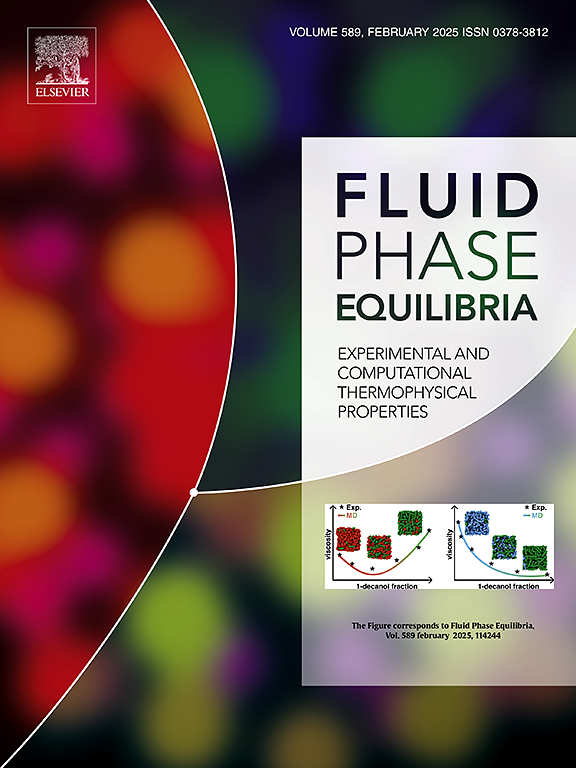二元水胺混合物粘性流动的部分摩尔性质
IF 2.7
3区 工程技术
Q3 CHEMISTRY, PHYSICAL
引用次数: 0
摘要
利用先前报道的单乙醇胺(MEA) +H2O、n -甲基二乙醇胺(MDEA) +H2O、二甲基乙醇胺(DMEA) +H2O和二乙基乙醇胺(DEEA) +H2O混合物的密度和粘度,从Eyring的粘度模型中计算黏性流动自由活化能ΔG*、黏性流动多余自由活化能ΔG*E和混合物中各组分黏性流动部分摩尔自由活化能ΔG¯i*的不同性质。用Redlich-Kister多项式方程表示ΔG*E,计算不同温度和胺摩尔分数下的ΔG¯i*。讨论了计算得到的ΔG¯i*对胺和水在不同混合物中的行为。我们将先前工作中报告的偏摩尔体积ΔV¯i的行为与ΔG¯i*进行比较,以确定这些特定混合物的相似性。本文章由计算机程序翻译,如有差异,请以英文原文为准。
Partial molar properties for the viscous flow of binary aqueous amine mixtures
Previously reported measured density and viscosities of Monoethanolamine (MEA) + H2O, N-methyldiethanolamine (MDEA) + H2O, Dimethylethanolamine (DMEA) +H2O, and Diethylethanolamine (DEEA) +H2O mixtures were used to calculate different properties of free energy of activation for viscous flow , excess free energy of activation for viscous flow and partial molar free energy of activation for viscous flow of the components in the mixture from Eyring’s viscosity model. Redlich-Kister polynomial equations were used to represent and calculate at different temperatures and amine mole fractions. The behaviour of calculated for amines and H2O in different mixtures was discussed. The behaviour of reported partial molar volumes from our previous work was compared with to identify any similarities for these particular mixtures.
求助全文
通过发布文献求助,成功后即可免费获取论文全文。
去求助
来源期刊

Fluid Phase Equilibria
工程技术-工程:化工
CiteScore
5.30
自引率
15.40%
发文量
223
审稿时长
53 days
期刊介绍:
Fluid Phase Equilibria publishes high-quality papers dealing with experimental, theoretical, and applied research related to equilibrium and transport properties of fluids, solids, and interfaces. Subjects of interest include physical/phase and chemical equilibria; equilibrium and nonequilibrium thermophysical properties; fundamental thermodynamic relations; and stability. The systems central to the journal include pure substances and mixtures of organic and inorganic materials, including polymers, biochemicals, and surfactants with sufficient characterization of composition and purity for the results to be reproduced. Alloys are of interest only when thermodynamic studies are included, purely material studies will not be considered. In all cases, authors are expected to provide physical or chemical interpretations of the results.
Experimental research can include measurements under all conditions of temperature, pressure, and composition, including critical and supercritical. Measurements are to be associated with systems and conditions of fundamental or applied interest, and may not be only a collection of routine data, such as physical property or solubility measurements at limited pressures and temperatures close to ambient, or surfactant studies focussed strictly on micellisation or micelle structure. Papers reporting common data must be accompanied by new physical insights and/or contemporary or new theory or techniques.
 求助内容:
求助内容: 应助结果提醒方式:
应助结果提醒方式:


